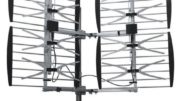An amplifier is an amplifier is an amplifier. What I mean is that there’s nothing actually different about the amplification process between a preamp and a distribution amp. In a pinch you could use either for either task. But there are some differences in the way they’re designed to function. Choosing the right amplifier for your installation will help you get the results you want.
Preamps
The main job of a preamp is to overcome a single long distance run from antenna to TV. Preamps can also be used to amplify weak signals so they travel more effectively down the cable and into the house. Preamps are usually weatherproof and only have one output. They’re also usually more powerful, such as this Winegard amplifier which increases the signal strength 100 times before it heads down the wire. That means that weak signals won’t be swallowed up by noise as they travel toward the house.
Preamps are usually powered through the coax cable so they need solid copper core cables. They also typically have the lowest noise figure of any type of amplifier, meaning they add less noise to the line. This makes sense, because the main purpose of this kind of amplifier is to keep the strongest possible signal-to-noise ratio. Signal-to-noise ratio, or SNR, is the most important measure of a digital signal, not raw signal strength.
Distribution Amps
A distribution amplifier is there to help you overcome the losses created by splitting the signal. Since they’re often used with splitters, distribution amps often come with multiple outputs. They’re usually not weatherproof since they’re designed to be used inside, and they usually have a lower power level. This distribution amp, for example, has 24dB of gain, about the highest number that you’ll find in a distribution amp. An 8-way splitter introduces 14dB of loss into the line – that’s just simple math since 14dB loss is just another way of saying 1/8 of the power. So this amp compensates for that and also has a little power left over so the signal leaving the amplifier is stronger than the signal that came in, even though you’ve split it 8 times.
Distribution amps are usually powered by plugging them into the wall. They typically allow a little more noise into the line than preamps. The role of a distribution amplifier is to overcome the raw signal loss caused by the lines and splitters, rather than to preserve signal-to-noise ratio. Generally, the small amount of added noise isn’t a problem.
Launch Amps
There’s a third kind of amplifier that is never used in homes. Launch amplifiers provide an amazing amount of amplification so that signals can travel from a master closet all over a large building. They are used in commercial settings. The signal that comes out of a launch amp is generally so strong that it will overload a TV tuner unless there’s a lot of cable or splitters in between. This sort of amplifier gives you great power, yes. But of course you know what they say. That power comes with the responsibility of knowing how it will be used.
And the bottom line…
As I said you could use a distribution amplifier for a preamp if it didn’t have a built-in splitter and you were using it in an attic. You could use a preamp as a distribution amp if you added a splitter to it. It’s just better to use them the way the manufacturer intends, right? That way you get the benefits of each.
If you’re looking for an amplifier or anything else to help you live your best digital life, shop the great selection at Solid Signal.





